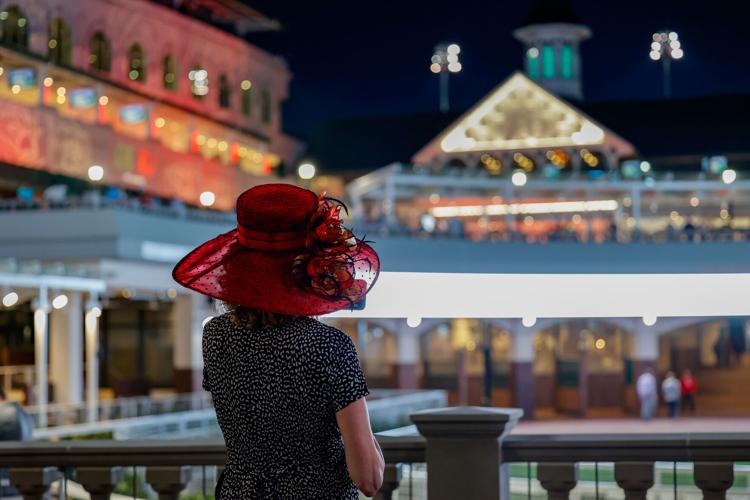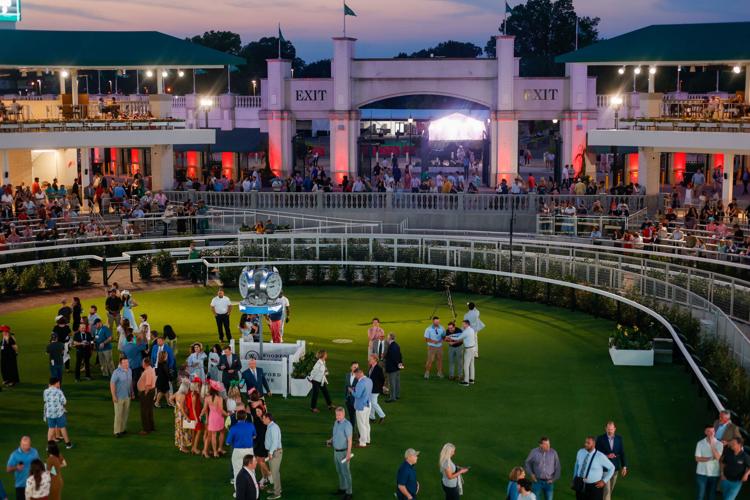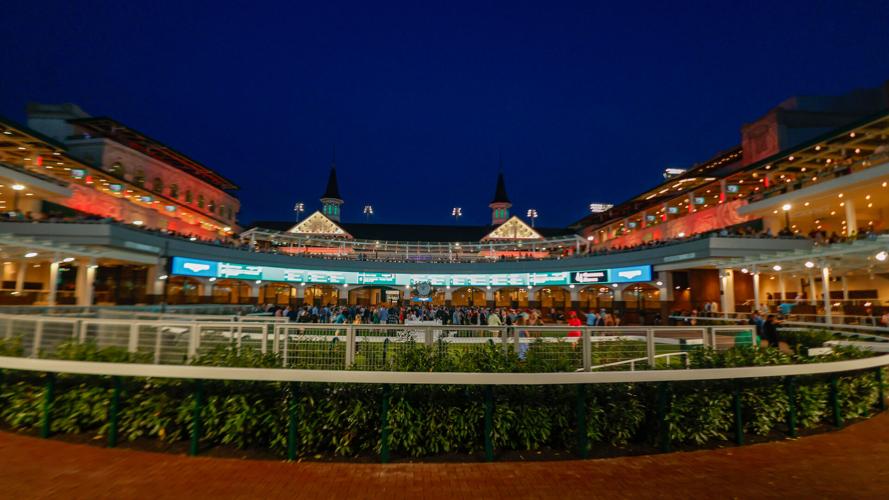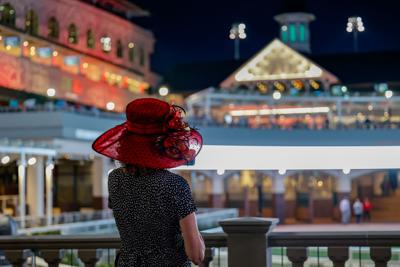LOUISVILLE, Ky. (WDRB) -- It's a little like Disney World, here at the entrance to Churchill Downs. You walk in, pass the statue of Aristides, the first Kentucky Derby winner, and there they are, the Twin Spires.
It's a rite of the new Churchill Downs. You stop, take a picture, snap a selfie or get someone else to take your picture. It's Cinderella's Castle with betting windows. It's Tinker Bell, in cowboy boots, with a fascinator.
Ride the shuttle, park a long way off, look at a bunch of chain-link fencing, temporary tents, walk through the paddock gate, see the horse statue and then, boom, it's a whole new word. Though, perhaps, not a small one.
Lights, camera, action. Flowers, horses, spires. A dream is a wish your heart makes. But an Exacta pays real money.
It's a good thing. Like Disney World, the place has gotten pretty pricey. Like the Magic Kingdom, it's one thing for the locals, and another for everyone else.
But as much as anything, the evolution of this place has traced — and sometimes paced — the history of this exceptional race, which will commemorate its 150th consecutive annual running this Saturday.
Horse racing, of course, is Frontierland. It's yesteryear. No longer do we get together with our best horses and race them in our spare time. "Street racing" had a far different connotation back in the day the Derby was established. Guys were racing their horses on Market Street, for goodness sake.
The Kentucky Derby exists at this crossroads, of black-and-white and color. For that reason, Churchill Downs can't run out of the gate and leave yesterday in the dust. For its purposes, the future doesn't work without its past, such as it is. It's Whirlaway, Citation and Secretariat. It hasn't always gotten that right. But as marketing sharps tend to do, they figure it out eventually.
"I think you come here and it's a place out of time," said Jessica Whitehead, curator of collections for The Kentucky Derby Museum. "It's a place out of time because it's stood the test of time for so long. So many generations of families, for example, have been coming to the Kentucky Derby, so many people come here to gather once a year with their friends, with their family, with their loved ones. And they come here to see these magnificent horses that make us so emotional. Think of the way people responded to horses like Secretariat and American Pharaoh, these absolute superstar horses that you can say, 'Look, they walked on these cobblestones, raced on this dirt track.' That means something to people. It's something physical that they can point to and say, yes, they were here, whether they mean Secretariat, or their ancestors were, or their family."

Images of Opening Night at Churchill Downs in Louisville, Ky. on April 27, 2024.
It's a beautiful sentiment. At the same time, nothing stands still.
Here at Churchill Downs, the new $200 million paddock, this is Tomorrowland. Twin Spires, meet the Twin Jumbotrons. The paddock construction introduced 3,600 new seats and 3,200 standing spots to view horses -- not racing, mind you, but getting ready to race. Above is a new paddock terrace, spacious with drinking and dining options on either side, the Spires immediately overhead.
For many of us who remember when Sports Illustrated was a magazine, not a club or resort, a good many of the new spaces created in recent years — the Homestretch Suites, the Paddock Club, the First Turn Club, the SI Club, the Spires Terrace, the Mansion and others — those are Fantasyland, at least during Kentucky Derby week. Millionaire's Row has spread. You can't stop urban sprawl.
And then, of course, back in the back, in the barns, you have Animal Kingdom, not the horse (2011 Kentucky Derby winner), but the place. It, too, during Derby week, ceases to be a place of business so much as a place to see and be seen, if only for a few days.
All of this, the building, the layout, the additions, the remaking of the physical structure, are part of an important mythology. Without it, the Derby isn't the Derby. It's just another horse race.
The Kentucky Derby, over the years, has been marketed as many things. It began as America's Yankee-doodle replica of England's Epsom Derby, the aristocratic owners, the plumage of well-to-do patrons, the attendant festival, the all-day celebration.
The Derby rose to national prominence in an age of nostalgia, playing on tropes of the old South and lost cause and ladies dressed like Scarlett O'Hara lounging around plantations. It added new imagery, adopted on old minstrel tune sentimentalizing slavery, and some other unfortunate though highly effective marketing ploys. (It also effectively eradicated the Black stars of the sport, who dominated the game in its early years).
The grandstand was extended in 1920. A steel paddock was added three years later. The year after that, in time for Kentucky Derby No. 50, another grandstand expansion came. And so did the people. The first radio broadcast, by 50,000-watt Louisville powerhouse WHAS, was made from inside one of the spires, in 1925. Celebrities. Babe Ruth came to the Derby. So did the Duke of Windsor. Electronic odds boards, infield tunnels, color photography, a Derby Museum. They all followed. All played into the growth of the event as a happening, a destination.
In 1965, a massive construction project signaled a new chapter in the Kentucky Derby's narrative – a large expansion of the grandstand, with two floors of suites, a press box. (Millionaires Row was born of this.)
More celebrities. Bob Hope, John Wayne.
More growth came. A turf course. New paddock. And in 2002, two new banks of luxury suites. As the facility grew into more of an entertainment complex, the Spires, though still in the center of the facility, receded in prominence. In 2010, permanent lights were installed.
Kim Kardashian came to the Derby. Queen Elizabeth. Jack Nicholson. Steven Spielberg.
As the event has evolved, it has continued to resonate with a nation that appreciates its tradition and maybe holds to its past more closely than it realizes. Horse racing, they keep saying, is a dying sport. But the Derby continues to thrive.
It is good television. Something in the neighborhood of 16 million tune in to watch the race. Outside of professional football, that's a significant sports audience. And it fits nicely into the modern sports marketing motif: hours of hype for two minutes of thrills.

Images of Opening Night at Churchill Downs in Louisville, Ky. on April 27, 2024.
But history, as they say, is forever. Matt Winn, the man whose vision, more than anyone's, created the modern Kentucky Derby, said that the growth of the structure was driven by the growth of the race, but sometimes it has been difficult to know which was driving which.
"This whole idea of each year, lots of new additions being added, lots of things being sandwiched on to each other, Matt Winn loved to describe that as a giant crazy quilt, which is so awesome," Whitehead said. "And he described it as stretching over half of Jefferson County, which is very funny. Hyperbole, but poetic hyperbole."
The Derby, and Churchill Downs, as much as any other major sporting event and venue in the United States, seem now to understand that whatever they build on top of it, their allure is history. It is of men and women on horseback and a bygone era. It's why those 1895 spires have been, in some ways, reframed to maximize their power as an icons in the present.
"In the 1980s, there was a lot of outcry as Churchill Downs was sort of building up and out and those massive white walls that were coming up all around the racetrack," Whitehead said. "... People said, 'You're obscuring the Twin Spires. That's the history. That's the thing.' But, of course, a racetrack has to be a balance between those two things. There has to be a balance, especially here at Churchill Downs, because of how iconic and long-lasting this history is. You have to have a balance of showcasing that history and being able to accommodate the people who are able to keep that history running. It's interesting with the paddock now, there's actually a very intentional attempt to showcase that 1895 grandstand, those architectural features, the Twin Spires, to bring them to the fore of these new vistas that the paddock is creating. I think the past is really informing the present in a way that's very pleasing."
Walt Disney once said, "Disneyland will never be completed."
That's the history of Churchill Downs, as home of the Kentucky Derby. It may not be a worldwide entertainment titan. But in its world, it is creeping closer to that place where every setting is a show of some kind, and every image produced depicts a place people would like to be, if only for a while.
It's not a fairy tale. Those of us who live here know that better than anyone. And the latest lowest price point — $130 for a simple infield ticket — is proof. Some locals are priced out. They are also priced out of the Final Four and Super Bowl and other major sporting events. They're priced out of Disney World and concerts. I'm priced out of them too.
But people still come. Someone is paying. Maybe not me or you, but a great many. More, in fact, than at most major sporting events in the U.S. Welcome to Derbyland. It still seems to have taken on a separate life of its own from a lot of us who grew up with it. But this one week a year, I also try to appreciate the desire of so many people from so many places to be part of this sporting castle in our midst.
Kentucky Derby 150 Coverage:
- BOZICH | Bob Baffert belongs in the Kentucky Derby again, D. Wayne Lukas says
- BOZICH | Why your favorite horse can win the Kentucky Derby — and why he won't
- MORNINGS AT CHURCHILL | A photo album of Kentucky Derby training
- BOZICH | How often does best horse win Kentucky Derby? Don't ask
Copyright 2024 WDRB Media. All Rights Reserved.














